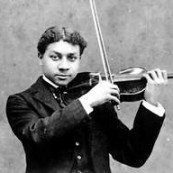| Country: | United States Of America |
| Period: | Romantique |
Biography
Clarence Cameron White (August 10, 1880 – June 30, 1960) was an African American neoromantic composer and concert violinist. Dramatic works by the composer were his best-known, such as the incidental music for the play Tambour and the opera Ouanga. During the first decades of the twentieth century, White was considered the foremost violinist of his race. He was a member of Alpha Phi Alpha fraternity.
Born in Clarksville, Tennessee to James W. White, a doctor and school principal, and Jennie Scott White, a violinist who studied at Oberlin Conservatory of music. His father died when he was only two years old.
White received his musical training in Oberlin, Ohio at the Oberlin Conservatory of Music where he was the only black student in the orchestra. In Washington, D.C., he attended Howard University from 1894–1895. At age eight he studied violin, first with Will Marion Cook and then he continued his studies with Martin Legowitz at age Twelve. He attended Oberlin Conservatory of Music 1896–1901, but before graduating he accepted a teaching position. As a teacher, he began teaching in the DC public schools and then quickly, in 1903 moved on to the Washington Conservatory of Music where he taught until 1907. His musical education continued later at the Hartford School of Music.
White was a protege of E. Azalia Hackley who raised money for his scholarship to allow him to study abroad. Traveling to London, he studied music with Samuel Coleridge-Taylor in 1906; he returned to the city again from 1908 to 1910 to study with M. Zacharewitsch. From 1924 to 1930, he continued teaching at Virginia State College and then at the Hampton Institute (1932—1935). In this period he wrote his best-known works: the ballet, A Night in Sans Souci—from the play Tambour, and the opera Ouanga. The lead role in Ouanga had been performed by baritone Lawrence Winters. These works are based on Haitian themes working with playwright and librettist John Matheus. During the period of 1930–1932, he studied with Raoul Laparra in Paris.
His compositions began as neoromantic pieces that were conventional for the period. 'Negro' folk music then served as an inspirational source. The early output of the composer included violin compositions and spiritual arrangements such as Forty Negro Spirituals (1927) and Traditional Negro Spirituals (1940). As he matured, the forms utilized by the composer became more varied. The 1954 Benjamin Award was presented to him for Elegy, a composition for orchestra. He also used decidedly 'Negro' themes for his string quartet and other chamber music. As a concert violinist he received critical praise. Often he toured throughout the United States, accompanied by his first wife of 36 years, pianist Beatrice Warrick White. Beatrice died at their home in Elizabeth, New Jersey, in October 1942; they had two sons who predeceased their mother. White soon moved to New Orleans and in 1943 remarried to Pura Belpré.







![The Heifetz Collection, Volume 19 [2 CD]](http://static.classicalm.com/repository/disk-cover/small/947-img1317413695600051.jpg)